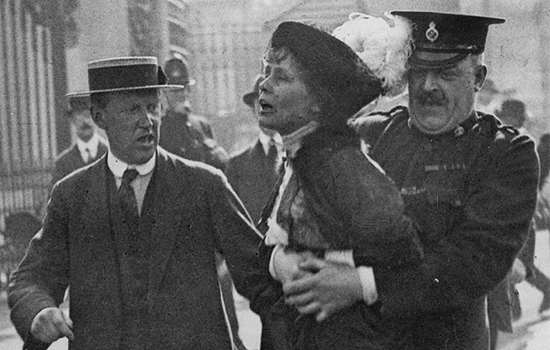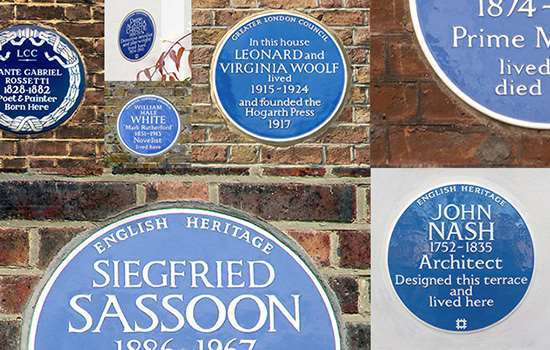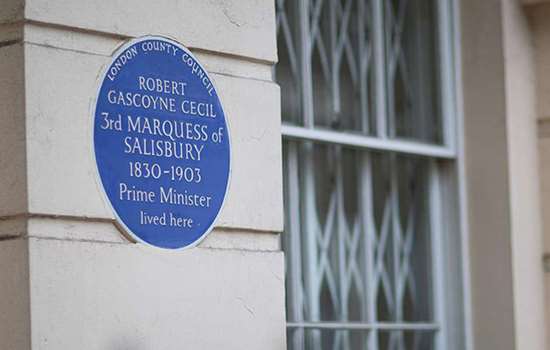GREENE, Graham (1904-1991)
Plaque erected in 2011 by English Heritage at 14 Clapham Common North Side, Clapham, London, SW4 0RF, London Borough of Lambeth
All images © English Heritage
Profession
Writer
Category
Literature
Inscription
GRAHAM GREENE (1904-1991) Writer lived here 1935-1940
Material
Ceramic
Henry Graham Greene was born in Berkhamsted, Hertfordshire, in 1904, the fourth of six children of Charles Henry Greene, a schoolteacher, and his wife Marion. He was educated at Berkhamsted School, where his father was headmaster, but was bullied so relentlessly while a boarder that he tried to kill himself. Aged 16 he ran away from school and was sent by his parents to London for psychiatric treatment, spending six months under the care of psychoanalyst Kenneth Richmond. Greene returned to complete his schooling as a day boy and it was at this point that he began writing what he later called "the most sentimental fantasies in bad poetic prose".
In 1922 Greene began studying history at Balliol College, Oxford where he met his future wife, Vivien Dayrell-Browning. Three years later, he published his first volume of verse, Babbling April, but poor reviews led him to abandon his hopes of being a poet, and instead he turned to journalism. Greene's first job was on the Nottingham Journal, where he worked unpaid for several months before landing a position as a sub-editor on The Times. His four-year stint at the paper proved one of the happiest periods of his life, enabling him to hone his editorial skills and started writing novels. It also coincided with his marriage to Vivien in 1927, having converted to Catholicism at her request. They went on to have two children.
1929 saw the publication of Greene's first novel The Man Within, which sold 13,000 copies. Its success and a publisher's advance led Greene to give up his job at The Times, believing he could write for a living. As he later wryly admitted, this proved to be a "false start", and his next two novels were failures.
Greene succeeded in salvaging his literary career in 1932 with Stamboul Train, which sold 21,000 copies in a year and earned him £1,500 in film rights. Although he dismissed this and subsequent thrillers such as A Gun for Sale (1936) and The Ministry of Fear (1943) as mere "entertainments", Greene applied the same discipline to these lighter novels as his more serious works, setting himself a daily target of writing five hundred words. These "entertainments" owed much to the cinema and were ideally suited to screen adaptation.
Greene proved a perceptive film critic for The Spectator (1935-1940) and for the weekly magazine Night and Day which he founded in 1937. His work as a reviewer bought him many contacts in the film industry and in 1936 he wrote The Green Cockatoo, the first of several screenplays for Alexander Korda. His fascination with the power of visual imagery culminated in his collaboration with Carol Reed in The Third Man (1949) which won the first prize at Cannes.
In 1936 Greene began writing Brighton Rock (1938), a thriller set in the seamy world of racecourse gangs that centred on Pinkie Brown, a ruthless killer. A trip to Mexico in 1938 inspired his next novel, The Power and the Glory (1940), which he finished just as war broke out. Greene remained in London during the Blitz, working for the Ministry of Information, and in 1941 joined the Secret Intelligence Service (MI6), spending sixteen months as an agent in Sierra Leone, which furnished him with material for The Heart of the Matter (1948). On returning to London in 1943, Greene worked under Kim Philby at the headquarters of MI6; he resigned from the service in 1944 but nevertheless continued to provide information unofficially to his MI6 contacts into the 1980s. Our Man in Havana (1958) drew on his experiences in the secret service.
In 1946 Greene embarked on a passionate love affair with Catherine Walston, the American born wife of Labour peer Henry Walston: she was the love of his life but her refusal to leave her husband and children, or her other lovers, drove Greene to distraction. He chronicled the pain of this relationship in The End of the Affair (1951), which he dedicated to "C". The affair petered out in the early 1960s by which time Greene was living mostly in the south of France with Yvonne Cloetta.
Most of his novels from these years are set in far-flung locations, such as Hanoi in The Quiet American (1955), Haiti in The Comedians (1966) and Argentina in The Honorary Consul (1972). Greene scored his greatest commercial success with his last major novel, The Human Factor (1978), a masterly evocation of London life which drew on many of his wartime experiences. He was appointed to the Order of Merit in 1986 and moved to an apartment on the shores of Lake Geneva in 1990. Greene died the following year in a hospital in Vevey, Switzerland, at the age of eighty-six.
14 Clapham Common North Side
The English Heritage blue plaque will be installed at 14 Clapham Common North Side, where Greene lived with his family from August 1935; at that time he described it as "a most beautiful Queen Anne house … done up absolutely like a museum piece". It remained his home until October 1940 when it was hit in a bombing raid and became uninhabitable.
The house was empty that night as Vivien and the children had been evacuated to Sussex and Graham was staying in Bloomsbury with his lover, Dorothy Glover. This devastating event later inspired the pivotal point in his novel, The End of the Affair. Despite the damage, the outer walls of the house remained intact, allowing the interior to be rebuilt after the war. The house is Grade II* listed and forms part of a terrace built by the architect John Hutt in 1714-20.
One of the Great British Writers
Greene's daughter, Caroline Bourget, said of the house:
“My father evacuated us to his parents' home in Sussex in August 1939 when I was only five years old, but I do remember the magnificent staircase. Some well-known writers and publishers visited the house such as John Betjeman and Evelyn Waugh. When I met them later, they recalled seeing me at the age of three or four.”
English Heritage blue plaque historian Dr Susan Skedd said:
“Graham Greene is indisputably one of the great British writers of the twentieth century. He achieved the rare distinction of enjoying both critical and popular admiration throughout his career. Since the centenary of his birth in 2004 his literary reputation has been increasing and we hope this plaque will act as a focus for old and new fans of his work alike.”
Nearby Blue Plaques
More About Blue Plaques



